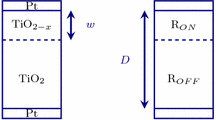Abstract
Since the outcoming of the memristor, memristive systems and mem-elements in electronics, new features for analog and digital circuit design have been introduced, and as a result models for the memristor are strongly needed in order to incorporate the device to the design flow loop. In this paper, a model for the memristor is introduced, it is generated by solving the differential equation, that governs the physical functioning of the device, by using a homotopy formulation. The generated model is recast in fully symbolic form that can be used to carry out behavioral simulation of circuits containing memristors.
























Similar content being viewed by others
References
Chua, L. O. (1971). Memristors-the missing circuit element. IEEE Circuit Theory, CT, 18, 507–519.
Stewart, G. R., Strukov, D. B., Snider, G. S., & Williams, R. S. (2008). The missing memristor found. Nature, 453, 80–83.
Ascoli, Alon, Corinto, Fernando, Senger, Vanessa, & Tetzlaff, Ronald. (2013). Memristor model comparison. IEE Circuits and Systems Magazine, 2, 89–105.
Li, H. H. & Hu, M. (2010). Compact model of memristors and its application in computing systems. In Design, automation, test in Europe conference and exhibition (DATE) (pp. 673–678).
Mahvash, M. & Parker, A. C. A Memristor SPICE model for designing memristor circuits. In 2010 53rd IEEE international midwest symposium on circuits and systems (MWSCAS) (pp. 989–992).
Pino, R. E., Bohl, J. W., McDonald, N. R., Wysocki, B. T., Rozwood, P. J., Campbell, K., Oblea, A. S., & Timilsina, A. (2010). Compact method for modeling and simulation of memristor devices. In NANOARCH ’09. IEEE/ACM international symposium on, nanoscale architectures, 2010 (pp. 1–4).
Rák, A., & Csery, G. (2010). Macromodeling of the memristor in SPICE. IEEE Transactions on Computer-Aided Design of Integrated Circuits and Systems, 29(4), 632–636.
Sarmiento-Reyes, A., Hernandez-Martinez, L., Hernandez Mejia, C., Diaz Arango, G. U., & Vazquez-Leal, H. (2014). A fully symbolic homotopy-based memristor model for applications to circuit simulation. In 2014 IEEE 5th latin American symposium on, circuits and systems (LASCAS) (pp. 1–4).
Chua, L. O., & Kang, S.-M. (1976). Memristive devices and systems. In Proceedings of the IEEE (pp. 209–223). IEEE.
Ventra, M. D., Pershin, Y. V., & Chua, L. O. (2009). Circuit elements with memory: Memristors, memcapacitors and meminductors. Proceedings of the IEEE, 97(10).
Kavehei, O., Iqbal, A., Eshraghian, K., Al-Sarawi, S. F., & Abbott, D. (2009). The fourth element: Characteristics, modelling and electromagnetic theory of the memristor. In: ICCCAS 2009. International conference on, communications, circuits and systems, 2009 (pp. 921–927).
Vázquez-Leal, H., Hernández-Martínez, L., Sarmiento-Reyes, A., & Castañeda-Sheissa, R.: Numerical continuation scheme for tracing the double bounded homotopy for analysing nonlinear circuits. In International conference on communications, circuits and systems (Vol. 205, pp. 1122–1126).
Ge, Renpu. (1990). Finding more and more solutions of a system of nonlinear equations. Applied Mathematics and Computations, 36, 15–30.
van der Laan, G., & Talman, A. J. J. (1981). A class of simplicial restart fixed point algorithms without an extra dimension. Mathematical Programming, 20, 33–48.
Ritcher, S. L., & DeCarlo, R. (1983). Continuation methods: Theory and applications. IEEE Transactions on Circuits and Systems, 30(6), 347–352.
Vandenberghe, L., & Vandewalle, J. (1990). Variable dimension algorithms for solving resistive circuits. International Journal of Circuit Theory and Applications, 18(5), 443–474.
Trajković, L., Sanders, S., & Fung, E. (1998). Homspice: Simulator with homotopy algorithms for finding dc and steady-state solutions of nonlinear circuits. In IEEE international sympsium on circuits and systems.
He, J. H. (2000). A coupling method of a homotopy technique and a perturbation technique for non-linear problems. International Journal of Nonlinear Mechanics, 35(1), 37–43.
Vazquez-Leal, H., Fernandez-Anaya, G., Khan, Y., Herrera-May, A., Sarmiento-Reyes, A., Filobello-Nino, U., Jimenez-Fernandez, V. M., & Pereyra-Diaz, D. (2012). A general solution for troesch’s problem. Mathematical Problems in Engineering, 1–14, 2012. doi:10.1155/2012/208375.
Biolek, D., Biolková, V., Kolka, Z., Biolek, Z. (2013). Some fingerprints of ideal memristors. In 2014 IEEE International Symposium on, Circuits and Systems (ISCAS) (pp. 1–4).
Biolek, Z., Biolek, D., & Biolkova, V. (2009). Spice model of memristor with nonlinear dopant drift. Radioenegineering, 18(2), 210–214.
Radwan, A. G., Zidan, M. A., & Salama, K. N. (2010) On the mathematical modeling of memristors. In 2010 International Conference on, Microelectronics (ICM) (pp. 284–287). IEEE.
Tetzlaff, R., Corinto, F., Gilli, M., Ascoli, A. (2013) PSpice switch-based versatile memristor model. In 2013 IEEE International Symposium on, Circuits and Systems (ISCAS) (pp. 205–208).
Pershin, Y. V., & Di Ventra, M. (2010). Memristive circuits simulate memcapacitors and meminductors. Electronics Letters, 46(7), 517.
Yener, S. C., Mutlu, R., & Kuntman, H. (2014). A new memristor-based high-pass filter/amplifier: Its analytical and dynamical models. In 2014 24th International Conference, Radioelektronika (RADIOELEKTRONIKA) (pp. 1–4). IEEE.
Rebhi, N., Samet, M., Kachouri, A., Fournier-Prunaret, D., & Charge, P. (2011). A simple uwb-chaotic generator based on memristor switching model. In 2011 8th International Multi-Conference on, Systems, Signals and Devices (SSD) (pp. 1–7).
Acknowledgments
Hector Vazquez-Leal gratefully acknowledges the financial support provided by the National Council for Science and Technology of Mexico (CONACyT) through Grant CB-2010-01 No. 157024. Gerardo Ulises Díaz Arango is currently a PhD student at INAOE with an academic scholarship under contract 387601.
Author information
Authors and Affiliations
Corresponding author
Rights and permissions
About this article
Cite this article
Sarmiento-Reyes, A., Hernández-Martínez, L., Vázquez-Leal, H. et al. A fully symbolic homotopy-based memristor model for applications to circuit simulation. Analog Integr Circ Sig Process 85, 65–80 (2015). https://doi.org/10.1007/s10470-015-0579-y
Received:
Revised:
Accepted:
Published:
Issue Date:
DOI: https://doi.org/10.1007/s10470-015-0579-y




